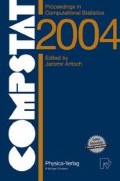Abstract
Conventional mosaic plot is to graphically represent contingency tables by tiles whose size is proportional to the cell count. The plot is informative when we are well trained reading this. This paper introduces a new approach for mosaic plot called line mosaic plot which uses lines instead of tiles to represent the size of the cells in contingency tables. We also give a general straightforward algorithm to construct the plot directly from the data set while the conventional approach is to construct the plot from the cross tabulation. We demonstrate the effectiveness of this tool for visual inference using a real data set.
Access this chapter
Tax calculation will be finalised at checkout
Purchases are for personal use only
Preview
Unable to display preview. Download preview PDF.
References
Catarci T., D’Amore F., Janecek P., Spaccapietra S. (2001). Interacting with GIS: from paper cartography to virtual environments. Unesco Encyclopedia on man-machine Interfaces, Advanced Geographic Information Systems, Unesco Press.
Cleveland W.S., McGill R. (1985). Graphical perception and graphical methods for analyzing scientific data. Science 229, 828–833.
Dawson R.J.M. (1995). The “unusual episode” data revisited. J. Statistics Education 3(3), 1–7.
Friendly M. (1994). Mosaic displays for multi-way contingency tables. Journal of the American Statistical Association, 89, 190–200.
Friendly M. (1999). Extending mosaic displays: marginal, partial, and conditional views of categorical data. Journal of Computational and Graphical Statistics 8, 373–395.
Hartigan J.A., Kleiner B. (1981). Mosaics for contingency tables. Eddy, W. F., (ed.), Computer Science and Statistics: Proceedings of the 13th Symposium on the Interface, 268–273. Springer-Verlag, New York, NY.
Hofmann H. (2000). Exploring categorical data: interactive mosaic plots. Metrika 5l(1), 11–26.
Hofmann H. (2003). Constructing and reading mosaic plots. Computational Statistics & Data Analysis 43, 565–580.
Huh M.Y., Song K.R. (2002). DAVIS: A Java-based data visualization system. Computational Statistics, 17(3), 411–423.
Ihaka R., Gentleman R. (1996). R: A language for data analysis and graphics. Journal of Computational and Graphical Statistics 5, 299–314.
Meyer D., Zeileis A., Hornik K. (2003). Visualizing independence using extended association and mosaic plots. DSC 2003 Working Paper, Institut for Statistik & Wahrscheinlichkeitstheorie, Technische University at Wien, Institut for Statistik, Wirtschaftsuniversity at Wien.
Unwin A. (2003). Variations on mosaic plots. Workshop on Modern Statistical Visualization and related topics(l) at ISM on 13-14, November 2003, ISM, Tokyo, Japan.
Wang C.M. (1985). Applications and computing of mosaics. Computational Statistics & Data Analysis 3, 89–97.
Author information
Authors and Affiliations
Editor information
Editors and Affiliations
Rights and permissions
Copyright information
© 2004 Springer-Verlag Berlin Heidelberg
About this paper
Cite this paper
Huh, M.Y. (2004). Line Mosaic Plot: Algorithm and Implementation. In: Antoch, J. (eds) COMPSTAT 2004 — Proceedings in Computational Statistics. Physica, Heidelberg. https://doi.org/10.1007/978-3-7908-2656-2_22
Download citation
DOI: https://doi.org/10.1007/978-3-7908-2656-2_22
Publisher Name: Physica, Heidelberg
Print ISBN: 978-3-7908-1554-2
Online ISBN: 978-3-7908-2656-2
eBook Packages: Springer Book Archive

